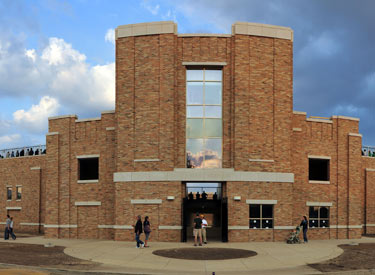
Alumni Stadium
 |
 |
 |
 |
 |
 |
 |
 |
 |
 |
 |
 |
 |
 |
 |
 |
| Purpose: Competition Only Capacity: 3,007 Date Construction Started: April 26, 2008 Date of Completion: September 1, 2009 Surface Type: Natural Grass Cost: $7.5 million Ticket Information Prohibited Items List |
A new era in Notre Dame soccer began in 2009, when the Fighting Irish men’s and women’s soccer teams took the pitch for the first time at the $7.5 million Alumni Stadium.
Located just east of Purcell Pavilion at the Joyce Center and approximately 500 yards west of its predecessor, the new stadium sits side-by-side with Notre Dame’s new lacrosse facility, Arlotta Stadium, which made its debut in the spring of 2010 (the soccer facility is situated further west, the lacrosse stadium further east).
Alumni Stadium opened its doors for Notre Dame soccer action on Sept. 1, 2009, when the Fighting Irish men blanked Michigan, 5-0. Three nights later, the Notre Dame women welcomed a sellout-crowd of 3,007 for its debut match against North Carolina.
A state-of-the-art facility that arguably is the finest on-campus soccer-specific stadium in the country, Alumni Stadium has a permanent seating capacity of approximately 2,500 in the west grandstand, including VIP boxes flanking the main team entrance, as well as grass berm seating on the east end of the grounds.
The stadium also offers upgraded and expanded restroom and concession areas, elevator access and handicapped reserved seating on the main concourse level, as well as numerous amenities for both Fighting Irish soccer programs (expansive locker rooms with custom-made wood lockers, spacious team lounges with flat-screen plasma TVs and high-speed Internet access, and a fully-equipped athletic training center).
What’s more, Alumni Stadium features an LED scoreboard (installed by industry leader Daktronics), enhanced lighting structures and top-of-the-line sod for the pitch cultivated in Fort Morgan, Colo., at Graff’s Turf Farms (which also provided the turf for some of the nation’s finest sports facilities including Notre Dame Stadium, Wrigley Field, Busch Stadium and two of the newest MLS grounds – Dick’s Sporting Goods Park in Commerce City, Colo., outside Denver, and Rio Tinto Stadium in Sandy, Utah, a suburb of Salt Lake City).
Media members enjoy a two-tiered, climate-controlled press box, which includes power and high-speed Internet portals at every seat (along with wireless Internet capability), three individually-wired broadcast booths and an expansive, unblocked and elevated midfield vantage point, all of which make Alumni Stadium unlike any other on-campus facility in college soccer. The construction of Alumni Stadium was made possible because of numerous generous donations, including those by lead benefactors Tom Crotty and Rob Snyder, both former Fighting Irish men’s soccer players.
Originally from Darien, Conn., Crotty starred for the Irish from 1977-79, playing midfield and fullback in 60 games, earning three monograms and finishing with 23 career points (eight goals, seven assists). He played in Notre Dame’s first three seasons of varsity soccer (under coach Rich Hunter), serving as one of the team captains as a senior in ’79. He was voted MVP of the ’79 Notre Dame team and led the Irish to a combined 57-14-3 record in those three years.
A 1980 Notre Dame graduate with a degree in finance, Crotty is currently a general partner with Battery Ventures LP in Wellesley, Mass. He and his wife Shari live in Southborough, Mass.
Hailing from Dallas, Texas, Snyder earned two monograms while playing forward, participating in 51 games in 1980-81-83 and accounting for 68 points (23 goals and 22 assists that rank him seventh on Notre Dame’s career chart). He tied for the team lead in goals in 1981 with 12. Snyder played on Hunter-coached teams that finished a combined 54-14-3 in his three seasons (including 35-3-1 at home).
Snyder is a 1984 Notre Dame graduate with a degree in government. He is the founder and CEO of Stream Energy in Dallas.
The gifts by Crotty and Snyder were components of the $1.5 billion “Spirit of Notre Dame” capital campaign, the largest such endeavor in the history of Catholic higher education. Alumni Stadium officially was dedicated on April 24, 2010, almost exactly two years to the day after ground was broken on the facility. Among those present were lead benefactors Crotty and Snyder and their families, along with members of the Notre Dame administration including University President Rev. John I. Jenkins, C.S.C., University Executive Vice-President John Affleck-Graves and Vice President and Director of Athletics Jack Swarbrick, as well as coaches and players from both the Fighting Irish women’s and men’s soccer teams.







